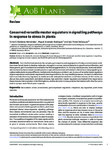
Please use this identifier to cite or link to this item:
http://ricaxcan.uaz.edu.mx/jspui/handle/20.500.11845/559Full metadata record
| DC Field | Value | Language |
|---|---|---|
| dc.contributor | 120833 | es_ES |
| dc.contributor.other | https://orcid.org/0000-0003-2949-1678 | - |
| dc.coverage.spatial | internacional | es_ES |
| dc.creator | Balderas Hernández, Victor Emmanuel | - |
| dc.creator | Alvarado Rodríguez, Miguel | - |
| dc.creator | Fraire Velázquez, Saúl | - |
| dc.date.accessioned | 2018-06-18T18:58:56Z | - |
| dc.date.available | 2018-06-18T18:58:56Z | - |
| dc.date.issued | 2013-08-11 | - |
| dc.identifier | info:eu-repo/semantics/publishedVersion | es_ES |
| dc.identifier.issn | 2041-2851 | es_ES |
| dc.identifier.uri | http://hdl.handle.net/20.500.11845/559 | - |
| dc.identifier.uri | https://doi.org/10.48779/3ban-z385 | - |
| dc.description | From the first land plants to the complex gymnosperms and angiosperms of today, environmental conditions have forced plants to develop molecular strategies to surpass natural obstacles to growth and proliferation, and these genetic gains have been transmitted to the following generations. In this long natural process, novel and elaborate mechanisms have evolved to enable plants to cope with environmental limitations. Elements in many signalling cascades enable plants to sense different, multiple and simultaneous ambient cues. A group of versatile master regulators of gene expression control plant responses to stressing conditions. For crop breeding purposes, the task is to determine how to activate these key regulators to enable accurate and optimal reactions to common stresses. In this review, we discuss how plants sense biotic and abiotic stresses, how and which master regulators are implied in the responses to these stresses, their evolution in the life kingdoms, and the domains in these proteins that interact with other factors to lead to a proper and efficient plant response. | es_ES |
| dc.description.abstract | En las plantas, desde las primeras especies terrestres hasta las complejas gimnospermas y angiospermas de la actualidad, las condiciones ambientales han forzado el desarrollo de estrategias moleculares para superar obstáculos naturales para crecer y proliferar, y estas ganancias genéticas han sido transmitidas a las generaciones subsiguientes. En este largo proceso natural, nuevos y elaborados mecanismos han evolucionado para permitir a las plantas luchar con las limitaciones ambientales. Elementos en muchas cascadas de señalización permiten a las plantas sensar diferentes, múltiples y simultáneas señales ambientales. Un grupo versátil de reguladores maestros que regulan la expresión génica, controla las respuestas de las plantas a las condiciones de estrés. Para propósitos de mejoramiento genético, la tarea es determinar como activar esos reguladores maestros, para habilitar las apropiadas y óptimas reacciones a diferentes formas de estreses comunes en el medio ambiente. En esta revisión, se discute como las plantas sensan el estrés biótico y abiótico, y como y cuales reguladores maestros están implicados en las respuestas a estos estreses, su evolución en los reinos de la vida, así como los dominios en esas proteínas que interactúan con otros factores que conducen a la apropiada y eficiente respuesta de defensa en la planta. | es_ES |
| dc.language.iso | eng | es_ES |
| dc.publisher | Oxford University Press | es_ES |
| dc.relation | https://watermark.silverchair.com/plt033.pdf?token=AQECAHi208BE49Ooan9kkhW_Ercy7Dm3ZL_9Cf3qfKAc485ysgAAAdQwggHQBgkqhkiG9w0BBwagggHBMIIBvQIBADCCAbYGCSqGSIb3DQEHATAeBglghkgBZQMEAS4wEQQMOILdMfPloV0l7A4-AgEQgIIBh2z2_JvD1GmRWQkG7Y7NCxUSCq-Rs----G-h57pl_H2dERsbgfQXlU7pPnhqps9z9bmU_7-sTootpEIeIcm9gufGZU9prGs3CDc5ZSZwjClIcdNN492Q5BjukzM48dThe9YY3Zq3DbIifUMitCHEJTglUtYLHG70MA7vR6jtTzlyNgGLukG6vLw-NrV8Mm-EnxKrGQdWuxkYP2LS8K5IHiUr91Pi205dN6OVle2YhmaMOhSL4IW6Vz6tymBq6tu3qx9qTt2gVIzgoDZE05NCi8XHd29I_QynakB9l1D9o39beeFcdWTjfk44axQWx8XNPo8nREYoNc11bQQ6DQO-_Q7QPmkKnjhTKpFnMa0OAR4_yc2fbnY3k2eYujNI1dTsUEmU-6tQ7T4FHPvQe91vQ6j_eJQ6PQIORx3K-IiT8IwM6fmGvCddqe0GK7D4FwhxWwjfxYvWjbymM8LcURO9SVzMj5l6Dme3gX2kQX13v4wBytcjsbyknfam9PymFh51WFT9jDyugx4 | es_ES |
| dc.relation.ispartof | https://academic.oup.com/aobpla | es_ES |
| dc.relation.isbasedon | PROMEP-SEP-Redes Temáticas de Colaboración 2011-UAZ-CA-138; Fondo Institucional de Fomento Regional para el Desarrollo Científico, Tecnológico y de Innovación- Doctores 174509 | es_ES |
| dc.relation.uri | generalPublic | es_ES |
| dc.rights | Atribución-NoComercial-CompartirIgual 3.0 Estados Unidos de América | * |
| dc.rights.uri | http://creativecommons.org/licenses/by-nc-sa/3.0/us/ | * |
| dc.source | AoB Plants, 5: plt033 | es_ES |
| dc.subject.classification | BIOLOGIA Y QUIMICA [2] | es_ES |
| dc.subject.other | estrés biótico/abiótico | es_ES |
| dc.subject.other | co-activadores | es_ES |
| dc.subject.other | regulación de la expresión génica | es_ES |
| dc.subject.other | integradores | es_ES |
| dc.subject.other | reguladores clave | es_ES |
| dc.subject.other | respuesta a estrés en planta | es_ES |
| dc.title | Conserved versatile master regulators in signalling pathways in response to stress in plants | es_ES |
| dc.type | info:eu-repo/semantics/article | es_ES |
| Appears in Collections: | *Documentos Académicos*-- UA Ciencias Biológicas | |
Files in This Item:
| File | Description | Size | Format | |
|---|---|---|---|---|
| AoB Plants_2013.pdf | Scientific article | 648,69 kB | Adobe PDF |  View/Open |
This item is licensed under a Creative Commons License
